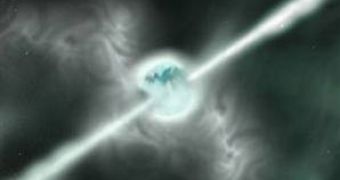From time to time, a huge explosion followed by a bright flash of light can be observed in space. It's a colossal gamma-ray burst (GRB), emitting for a few seconds as much radiation as a million galaxies.
They are the most luminous events known in the universe since the Big Bang. They are flashes of gamma rays, coming from seemingly random places in the sky and at random times, that last from milliseconds to many minutes and are often followed by "afterglow" emission at longer wavelengths (X-ray, UV, optical, IR, and radio). Gamma-ray bursts are currently detected by orbiting satellites about once a day.
Most astronomers seem to agree that the only thing that could spark the bright flash is the birth of a black hole, but little is known about what converts the newborn black hole's energy into the radiation that astronomers detect. The majority of observed GRBs appear to be due to collimated emission (that is, emission in narrow jets) from the core-collapse of a rapidly rotating Wolf-Rayet star into a black hole, but a specific subclass of GRBs (the "short" bursts) appears to be due to another process, possibly the collision of two neutron stars orbiting in a binary.
However recent observations are not so convinced that a high-speed jet of hot material is the cause, but rather that the "trigger" is a high-powered magnetic beam.
There is now an almost universal agreement in the astrophysics community that the long-duration bursts are associated with the deaths of massive stars in a specific kind of supernova-like event commonly referred to as a collapsar. Very massive stars are able to fuse material in their centers all the way to iron, at which point a star cannot continue to generate energy by fusion and immediately collapses - in this case, immediately to a black hole. Matter from the star around the core rains down towards the center and (for rapidly rotating stars) swirls into a high-density accretion disk.
The infall of this material into the black hole drives a pair of jets out along the rotation axis (where the matter density is much lower than in the accretion disk) towards the poles of the star at velocities approaching the speed of light, creating a relativistic shock wave at the front. If the star is not surrounded by a thick, diffuse hydrogen envelope, this material can pummel all the way to the stellar surface. The leading shock actually accelerates as the density of the stellar matter it is traveling through decreases, and by the time it reaches the surface of the star it may be traveling with a 0.9 of the speed of light.
Once it reaches the surface, the shock wave breaks out into space and much of this energy can be released in the form of gamma-rays.
But the Swift satellite, NASA's dedicated GRB observatory, has detected a number of GRBs that appear to defy the established model.
What we are finding is that the central engine is not dying immediately but continues to inject energy into the flow for thousands of seconds," said theorist Dimitrios Giannios of the Max Planck Institute for Astrophysics in Garching, Germany. "This long activity is more consistent with magnetic models."
A model that may describe a small subset of short GRBs are the so-called magnetar giant flares (also called megaflares or hyperflares). It has been well-known for several decades that members of a rare class of powerfully magnetized neutron stars known as "magnetars" (only five such objects are known in our Galaxy) are capable of producing brief but enormous outbursts of high-energy photons.
Indeed the new observations on a sample of 10 GRBs found that the estimated location of gamma ray emission was more consistent with magnetic outflows, so this could really be a new explanation for these spectacular bursts.

 14 DAY TRIAL //
14 DAY TRIAL //